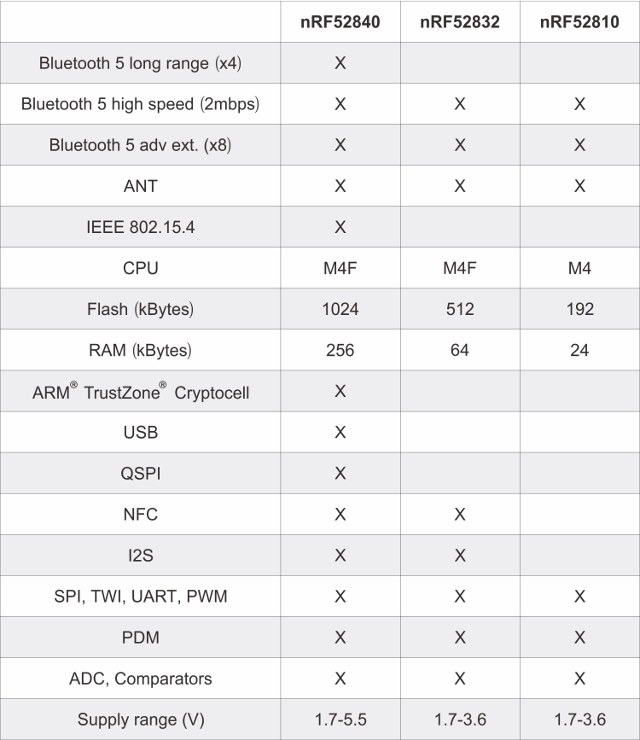Bluetooth 5 was formally introduced earlier this year with promises of four times the range, and twice the speed. Several companies offer chips that are compatible with the new standard, and among them Nordic Semi offers Bluetooth 5 ready solutions via nRF52840, nRF52832, nRF52810 Bluetooth SoCs. However, if you thought – like I did – that all three would provide the same Bluetooth 5 support with just some differences in memory, storage and performance, a comparison table put together by Raytac Corporation will show that among the three SoCs only nRF52840 will support the longer range, while the two older SoC only support the extra bandwidth offered by Bluetooth 5.
 I could find a blog post about a long range demo that confirms the above:
I could find a blog post about a long range demo that confirms the above:
Two nRF52840 Preview Development Kits (PDK) or nRF52832 Development Kits. A combination of the two different kits can also be used. Notice that if the nRF52832 Development Kit is used, the long-range feature will not work as this is only possible with the nRF52840.
That blog post also gives some ideas about the achievable bitrates for different modes:
The throughput measured may vary depending on the environment, but the maximum throughput should be around 1365 Kbps for BLE 5 High Speed, 775 Kbps for BLE 4.2, 128 Kbps for BLE 4.1 and 21.3 Kbps for BLE 5 Long Range. Be aware that there may be some inaccuracies in the measurements.
The main takeaway here is that if you are going to select an SoC, development board, or product with Bluetooth 5 connectivity, long range support may not always be supported, and if that feature is important to your use case, you should make sure the hardware supports it.

Jean-Luc started CNX Software in 2010 as a part-time endeavor, before quitting his job as a software engineering manager, and starting to write daily news, and reviews full time later in 2011.
Support CNX Software! Donate via cryptocurrencies, become a Patron on Patreon, or purchase goods on Amazon or Aliexpress





> “with promises of four times the range, and twice the range.”
I think that is meant to say “four times the range, and twice the speed”.
The development kit for the nRF52840 is currently listed as $46.25 from a popular vendor. In contrast, an ESP32 development kit can be had for $12.00 or less. While the latter is only BT4.2, the price difference is important when it comes to adoption by the “Maker” community. In matters of IoT, cost is a very critical factor due to volume (many devices instead of one).
@crashoverride
Problem is when your turn Bluetooth on the ESP32 current consumption goes up to 100+ mA. (Same as WiFI) For now at least it’s totally unsuitable for most applications where you’d use a Nordic chip.
If cost is your only concern you might as well use a Raspberry Pi Zero W.
@JM
For BT LE, the power budget is entirely up to your application. It is not an “always on” scenario as with classic BT: you turn the radio off when not in use. The ESP32 has very low power (micro amps) operation modes just like nRF52840. The same can not be said for PI 0 W. The other issue, of course, is availability which make PI 0 unsuitable for any serious use.
(web site ate my post (2 times), but I was ready for it this time!)
@crashoverride
The ESP32 (in the current ESP-IDF) doesn’t cycle the BLE radio as you suggest. You can’t turn it fully off and hope to meet the connection intervals required to maintain a connection up.
Also turning the entire radio on and off on the ESP32 carries a big power budget cost, you need to run an intensive RF calibration each time.